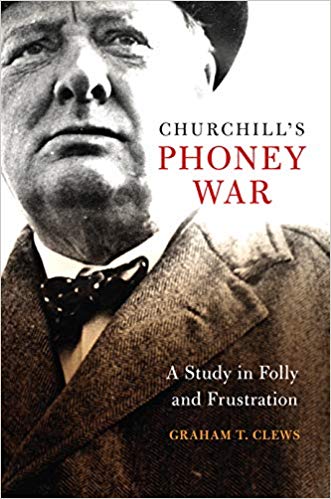The Challenges of Crisis Management: The ‘Phony War” as a Case Study
The recently published book by Graham T. Clews on Churchill’s Phony War is a fresh look at the period between the seizure of Poland and the full out assault on the rest of Europe.
It provides a significant update from original sources concerninghe inside baseball of the British government, notably the War Cabinet, with regard to the period of the Phony War.
As such, it provides a significant contribution to understand the Churchill-Chamberlin transition.
But it also provides insights into the challenges facing liberal democracies in dealing with aggressive authoritarian regimes generating a crisis.
What is clear from the book was that even the seizure of Poland did not make it clear to the French and British leaders of what was coming next and how to prepare an all-out response to Hitler.
There was no consensus on what France and Britain should do with regard to the low countries, including whether mounting a direct defense made sense.
The British argued for the use of their longer-range bombers to attack the German industrial heartland at some point during the phony war, but there was no consensus on the timing either on the British side or with the French.
But while the RAF argued for long range bombing, the French leadership wanted the bomber force to provide for tactical support to the defense of France.
In addition, there was the Royal Marine initiative which focused on the use of a proactive Royal Navy effort to mine critical supply lines which would affect German military potential as well. Operation Royal Marine was a scheme to float mines down the Rhine river to disrupt internal support efforts by the German forces.
According to Clews: “The common thread in this study of airpower and Royal Marine is the determination displayed by the British and the French to fight the war with as little harm as possible to their respective countries.
“This was, after all, the essence of the sitting tight and rearming long war view with which Churchill agreed.” (p 154)
The crucial point in the Phony War where reality injected itself was the question of Scandinavia.
Churchill and others in the War Cabinet wanted to find ways to get Sweden to work with the allies to disrupt iron ore supplies to the Reich. And with the Soviet invasion, the British were hoping to get the Finns to side with the allies to oppose the Soviet operation as well.
But there was a very tangled history here of Finland and the Western allies and any real support to deal with the Soviet invasion.
Most notably, and of importance to forging effective crisis management against authoritarian powers, is an ability to see clearly both the political and military strategies likely to be pursued by an authoritarian regime against a coalition of liberal democratic states.
Here the lessons are largely negative from the Phony War period.
The actual military strategy to be followed by the Germans was not the focus of attention.
Indeed, the largely political decision to prepare for a defensive operation to work with the low countries, actually put the British and French forces where the Germans wanted them, in light of their actual warfighting strategy to go through the Ardennes.
And the way the Germans conducted their campaign against Norway was not anticipated to any significant extent.
The amphibious and land operations would create much more rapid and significant effects in the control of Norway and Denmark, than the British anticipated, or the First Sea Lord, Winston Churchill, prepared for.
“From the beginning, operations in Norway, and possibly Sweden, had been based on the dubious assumption that fighting in this theater would impose a greater burden on the Germans than on the Allies while also offering the prospect of denying Germany access to Swedish ore.
“Churchill championed the view, also accepted by the Chief of Staff, that sea power would allow the Allies to match or exceed the effort needed by the Germans to capture and control Norway via the long and limited lines of land communications.” (p 230).
This is an important book for students of World War II and Churchillian studies but also helpful in understanding the steep challenge for liberal democracies to prevail in crises with authoritarian regimes.
Such crises unfold in conditions where the military strategies are better masked than our own, and where the thinking and tactical approaches which authoritarian leaders are likely to take are not knowable through the open political processes which, on our side, inform authoritarians of what the liberal democracies are likely to do, to tolerate, or actions likely to be pursued.
This asymmetric situation is to be assumed as a core challenge, rather than just wished away.
When the Germans had taken Western Poland, leaders in Western Europe could still believe that perhaps Germany would exercise restraint and sought to pursue tactics and strategies to give each of the large nations their own strategic advantages.
This was hardly a coalition which could stop Hitler; and now we face the historical question of whether the liberal democracies acting as a coalitions, even of coalitions of the willing, can think and act effectively enough and in a timely manner to deter decisive actions which authoritarian regimes might take against our interests.
https://www.usni.org/press/books/churchills-phoney-war
https://www.amazon.com/Churchills-Phoney-War-Frustration-Studies/dp/1682472795

